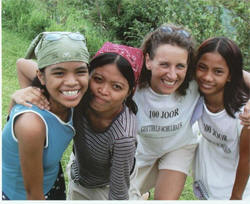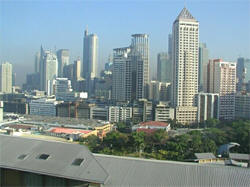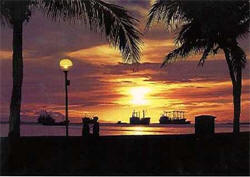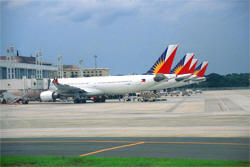�

�
About OutsourceIT2philippines
- Outsourceit2philippines.com is a subsidiary company of Hubport Interactive Inc.
- The OIT2P team evaluates clients' businesses and identifies what kind of Internet presence they need.
- The OIT2P Management Team has significant professional management experience
- Our seven servers are located in two state-of-the-art data centers in Houston, Texas

�



Manila is the capital city of the Philippines. The city stands on the eastern shore of Manila Bay on the largest and northernmost Philippine island, Luzon. Despite pockets of grinding poverty, it is one of the most cosmopolitan cities in the world and its metropolitan area is the country's economic, cultural, educational, and industrial center.
Manila is the hub of a thriving metropolitan area of more than 10 million people. The Metro Manila area, to where the City of Manila belongs, is a much bigger metropolis consisting of 17 cities and municipalities. This article discusses the city itself; see Metro Manila for the article on the metropolis.
The city itself is the Philippines' second most populous city at more than 1.5 million inhabitants. Only Quezon City, a suburb and the country's former capital, is more populous. Manila is located at 14�35' North, 121�0' East (14.58333, 121.0).
In the 16th century, Manila grew from a Muslim settlement on the banks of the Pasig River into the seat of the colonial government of Spain when it controlled the Philippine Islands for 333 years.  In 1898 the U.S. occupied and controlled the archipelago until 1935 and Manila became an internationally-known city in the Orient. During World War II, much of the city was destroyed, but was eventually rebuilt. In 1975, to better manage the affairs of the fast-growing region, the city of Manila and the surrounding towns and cities were incorporated into an independent entity, Metropolitan Manila. This was enacted on November 8, 1975 via Presidential Decree # 824 by former president Ferdinand Marcos calling for a creation of a Metropolitan Manila Commission, its function now being carried out by the Metro Manila Development Authority. Today, the city and the metropolis thrives as an important cultural and economic center. However, overpopulation, traffic congestion, pollution, and crime challenge the city.
In 1898 the U.S. occupied and controlled the archipelago until 1935 and Manila became an internationally-known city in the Orient. During World War II, much of the city was destroyed, but was eventually rebuilt. In 1975, to better manage the affairs of the fast-growing region, the city of Manila and the surrounding towns and cities were incorporated into an independent entity, Metropolitan Manila. This was enacted on November 8, 1975 via Presidential Decree # 824 by former president Ferdinand Marcos calling for a creation of a Metropolitan Manila Commission, its function now being carried out by the Metro Manila Development Authority. Today, the city and the metropolis thrives as an important cultural and economic center. However, overpopulation, traffic congestion, pollution, and crime challenge the city.
The Seal of Manila depicts the words Lungsod ng Maynila and Pilipinas, Filipino for City of Manila and Philippines, in a circle around a shield. The circle also contains six yellow stars representing the city's six congressional districts. The shield, in the shape of pre-colonial people's shield, depicts the city's nickname Pearl of the Orient on top; a sea lion in the middle, in reference to the city's Spanish influences; and the waves of the Pasig River and Manila Bay in the bottom portion. The colors of the seal mirror that of the Flag of the Philippines.
The City
Manila, PhilippinesManila lies at the mouth of the Pasig River on the eastern shores of Manila Bay, which is on the western side of Luzon. It lies about 950 kilometers southeast of Hong Kong and 2,400 kilometers northeast of Singapore. The river bisects the city in the middle. Almost all of the city sits on top of centuries of prehistoric alluvial deposits built by the waters of the Pasig River and on some land reclaimed from Manila Bay. The layout of the city was haphazardly planned during Spanish Era as a set of communities surrounding Intramuros. Intramuros is the original walled-city of Manila. During the American Period, some semblace of city planning using the architectural designs by Daniel Burnham, was done on the portions of the city south of the Pasig River.

Manila is bordered by several municipalities and cities in Metro Manila: Navotas and Caloocan City to the north, Quezon City to the northeast, San Juan and Mandaluyong City to the east, Makati City to the southeast, and Pasay City to the south.
The city is divided into 16 geographical districts. Only one district was not an original town-Port Area. The eight districts north of the Pasig are Binondo, Quiapo, Sampaloc, San Miguel, San Nicolas, Santa Cruz, Santa Mesa, and Tondo. The other eight are Ermita, Intramuros, Malate, Paco, Pandacan, Port Area, San Andres, and Santa Ana. San Andres was previously part of Santa Ana, and Santa Mesa, once a part of Sampaloc.
All of these districts, with the exception of Port Area, have their own churches, and several of the these districts have achieved recognition in their own right. The district of Binondo is the city's Chinatown. Tondo is the poorest, while the districts of Ermita and Malate are well-known and popular with tourists, having many bars, restaurants, five-star hotels, and shopping malls.
The Pasig River is crossed by a number of bridges in Manila. Eastward they are Roxas Bridge (commonly referred to as the Del Pan Bridge), Jones Bridge, McArthur Bridge, Quezon Bridge, Ayala Bridge, Nagtahan Bridge (also known as Mabini Bridge), Pandacan Bridge, and Lambingan Bridge.
World's Most Densely Populated City
With a population of 1,654,761 recorded in 1995 and a land area of 38.52 sq. km., it has the highest population density of any city in the world with 43,258 people per sq. km. (with district 6 being the most dense with 68,266, followed by the first two districts (Tondo) with 64,936 and 64,710, respectively, and district 5 being the least dense with 19,235). A million more transients are added during daytime as students and workers come to the city.
Manila's population density dwarfs that of Shanghai's (16,364 people per sq. km., with its most dense district of Nanshi's 56,785 density); Buenos Aires' (2,179 people per sq. km., with its most dense inner suburb Lans' 10,444 density); Tokyo's (10,087 people per sq. km.); Mexico's (11,700 people per sq. km.); and Istanbul's (1,878 people per sq. km., with its most dense district Fatih's 48,173 density). �
Parks and Open Areas
Rizal ParkDirectly south of Intramuros lies Rizal Park, the country's most significant park. Also known as Luneta (Spanish term for "crescent or moon") and previously as Bagumbayan, the 60-hectare Rizal Park sits on the site where Jos� Rizal, the country's national hero, was executed by the Spaniards on charges of subversion.  A monument stands in the park for his honor where Rizal was buried. Rizal Monument is the Kilometer Zero for road distances on the island of Luzon. Some attractions of Rizal Park include the Chinese and Japanese Gardens, the Department of Tourism, the National Museum of the Filipino People, The National Library of the Philippines, the Planetarium, an open-air auditorium for cultural performances, a relief map of the Philippines, a fountain area, a children's lagoon, a chess plaza, a light and sound presentation, and the Quirino Grandstand.
A monument stands in the park for his honor where Rizal was buried. Rizal Monument is the Kilometer Zero for road distances on the island of Luzon. Some attractions of Rizal Park include the Chinese and Japanese Gardens, the Department of Tourism, the National Museum of the Filipino People, The National Library of the Philippines, the Planetarium, an open-air auditorium for cultural performances, a relief map of the Philippines, a fountain area, a children's lagoon, a chess plaza, a light and sound presentation, and the Quirino Grandstand.
Another famous open space in Manila is the Baywalk. This promenade lies in front of the Manila Bay where you can experience one of the breathtaking sunsets of the world. Coconut trees, giant kaleidoscopic lamp posts, al fresco caf�s and restaurants, and live acoustic bands dot this two-kilometer stretch of ample space beside Roxas Boulevard.
Aside from Rizal Park, Manila has very few other open public spaces. Rajah Sulayman Park, Manila Boardwalk, Liwasang Bonifacio, Plaza Miranda, Paco Park, Adriatico Circle, Manila Zoological and Botanical Garden, and the Malaca�ang Garden are some of the other parks in the city. In the northernmost part of the city lies the three cemeteries of Loyola, Chinese, and Manila North Green Park.
Public Markets and Shopping Malls
Every district in the city with the exception of Port Area has its own public market, locally called the pamilihang bayan. Public markets are often divided into two, the dry goods section and the wet goods section. Commerce in these public markets are in full swing, especially in the early morning. Under the urban renewal program of the incumbent administration, some of the public markets had been refurbished and given a fresher look, like the Sta. Ana public market. It is one of the more advanced markets in the city featuring a modern 2-story building with an escalator. The tropical climate in Manila plus the facilities of its world-class malls continue to attract Filipinos to the shopping malls. Modern shopping malls dot the city especially in the areas of Malate and Ermita. SM City Manila, part of the country's largest chain of malls, stands behind the Manila City Hall. One of the popular malls that lies at the heart of Manila is Robinson's Place Ermita. In the southern part of the city in Malate district is Harrison Plaza, one of the city's oldest shopping malls. For the adventurous shoppers, you may venture beyond the hotel/shopping complex package and combine other interesting destinations for cheap buys such as in Divisoria and Quiapo districts. Bargaining is the major part of your shopping experience when you pass by on these areas, as it sells goods at rock-bottom prices. In Divisoria, there is already a shopping mall that caters to the adventurous shoppers. Tutuban Center in Divisoria gives a little comfort to the shoppers as it offers air-conditioned mall, but the price of the goods here is still very similar to the goods bought outside. In Quiapo, one unique spot is the marketplace under the bridge. It sells indegineous Filipino crafts and delicasies. Raon Center is famous for its cheap electronic products. Though through the changing times, department stores began sprouting the Quiapo area, but still the flea market of Quiapo is still vibrant and very much popular among the average Filipinos.History
Manila began as a Muslim settlement at the mouth of the Pasig River along the shores of Manila Bay. The name came from the term maynilad, literally "there is nilad." Nilad is a white-flowered mangrove plant that grew in abundance in the area. In the mid-1500s, the areas in present-day Manila was governed by three rajahs, or Muslim community leaders. They were Rajah Sulayman and Rajah Matanda who ruled the communities south of the Pasig, and Rajah Lakandula who ruled the community north of the river. Manila was then the northernmost Muslim sultanate in the islands. It held ties with the sultanates of Brunei, Sulu, and Ternate in Cavite. Arrival of the Spanish In 1570, a Spanish expedition ordered by the conquistador Miguel L�pez de Legazpi demanded the conquest of Manila. His second on command, Martin de Goiti departed from Cebu and arrived in Manila. The Muslim and indigenous Tagalogs welcomed the foreigners, but Goiti had other plans. The Spanish force of 300 soldiers marched through Manila and a battle was fought with the heavily armed Spaniards quickly defeating and crushing the native settlements to the ground. Legazpi and his men followed the next year and made a peace pact with the three rajahs and organized a city council consisting of two mayors, 12 councilors, and a secretary. A walled City known as Intramuros, at the southern banks of Pasig River was built to protect the Spanish colonizers. On June 10, 1574, King Philip II of Spain gave Manila the title of Insigne y Siempre Leal Ciudad ("Distinguished and Ever Loyal City"). In 1595, Manila was proclaimed as the capital of the Philippine Islands. U.S. Occupation and Period Escolta Street, Manila. stereoptical view, 1899The headquarters for USAFFE were located here as were the U.S. 31st Infantry Regiment and the U.S. 808th Military Police Company. The headquarters and bulk of the Philippine Division was located just to the south, at Fort William McKinley. The headquarters for the Far East Air Force was on the outskirts of town, at Nielson Field. Nearby, at Nichols Field was the U.S. 20th Air Base Group. A battalion of the U.S. 12th Quartermaster Regiment was located in the port area and training was conducted there for quartermasters of the Philippine Army. There were 6 airfields, for the Far East Air Force, within 130 km of Manila, notably Clark, Nichols, and Nielson fields.Transportation
 Ninoy Aquino International Airport serves Manilla and the metro area, and over 30 airlines provide daily service to major cities around the world. NAIA is the main hub of Asian Spirit, Cebu Pacific, Philippine Airlines, and South East Asian Airlines and is a hub of Air Philippines.
Ninoy Aquino International Airport serves Manilla and the metro area, and over 30 airlines provide daily service to major cities around the world. NAIA is the main hub of Asian Spirit, Cebu Pacific, Philippine Airlines, and South East Asian Airlines and is a hub of Air Philippines.
Manila and Security
Manila has been subject to militant attacks. The metropolis have been targeted twice by groups Moro Islamic Liberation Front and Abu Sayyaf. In addition, Al-Qaida cells have been discovered in the metropolis. Project Bojinka, which was a large-scale attack being planned in late 1994 and early 1995, was being planned in Manila. The project was abandoned after the night of January 6, 1995 and the morning of January 7, when an apartment fire led investigators to a laptop computer containing the plans.




